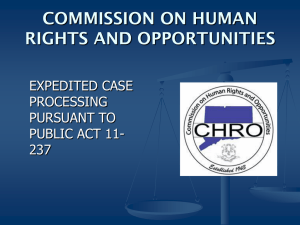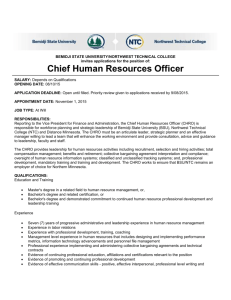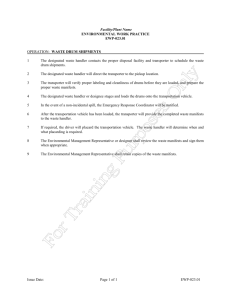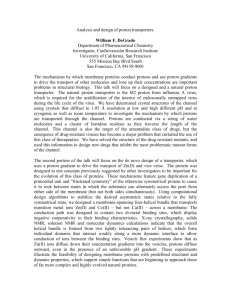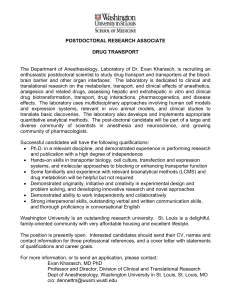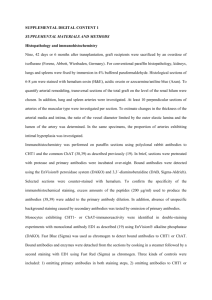Final Report 2004 - Virginia Commonwealth University
advertisement
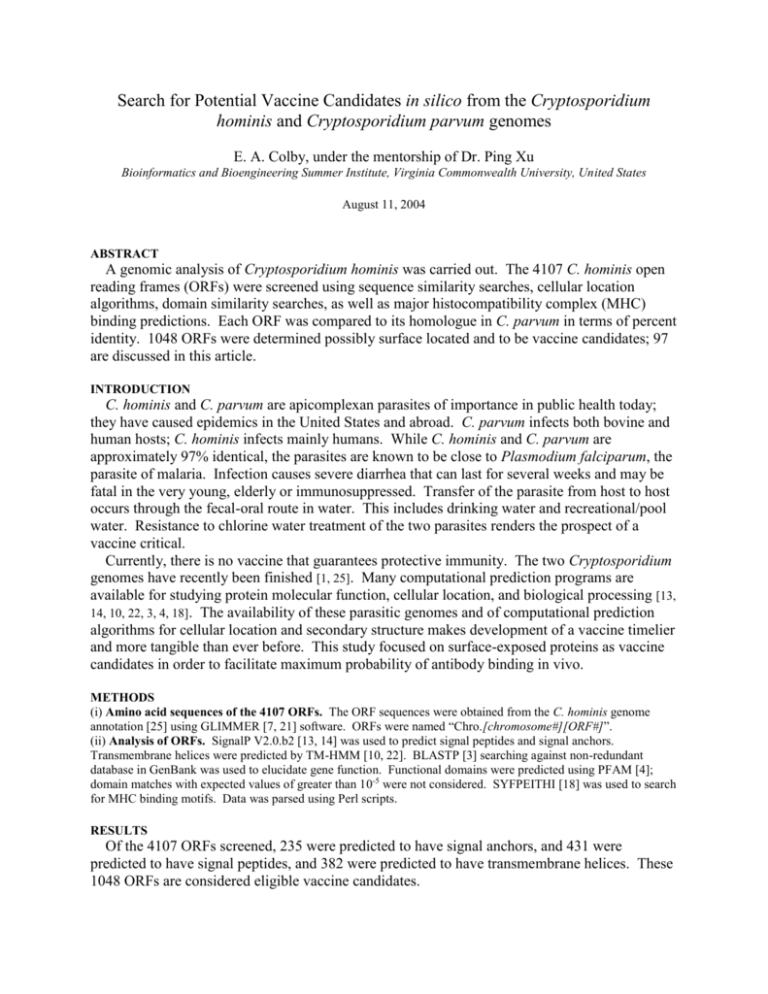
Search for Potential Vaccine Candidates in silico from the Cryptosporidium hominis and Cryptosporidium parvum genomes E. A. Colby, under the mentorship of Dr. Ping Xu Bioinformatics and Bioengineering Summer Institute, Virginia Commonwealth University, United States August 11, 2004 ABSTRACT A genomic analysis of Cryptosporidium hominis was carried out. The 4107 C. hominis open reading frames (ORFs) were screened using sequence similarity searches, cellular location algorithms, domain similarity searches, as well as major histocompatibility complex (MHC) binding predictions. Each ORF was compared to its homologue in C. parvum in terms of percent identity. 1048 ORFs were determined possibly surface located and to be vaccine candidates; 97 are discussed in this article. INTRODUCTION C. hominis and C. parvum are apicomplexan parasites of importance in public health today; they have caused epidemics in the United States and abroad. C. parvum infects both bovine and human hosts; C. hominis infects mainly humans. While C. hominis and C. parvum are approximately 97% identical, the parasites are known to be close to Plasmodium falciparum, the parasite of malaria. Infection causes severe diarrhea that can last for several weeks and may be fatal in the very young, elderly or immunosuppressed. Transfer of the parasite from host to host occurs through the fecal-oral route in water. This includes drinking water and recreational/pool water. Resistance to chlorine water treatment of the two parasites renders the prospect of a vaccine critical. Currently, there is no vaccine that guarantees protective immunity. The two Cryptosporidium genomes have recently been finished [1, 25]. Many computational prediction programs are available for studying protein molecular function, cellular location, and biological processing [13, 14, 10, 22, 3, 4, 18]. The availability of these parasitic genomes and of computational prediction algorithms for cellular location and secondary structure makes development of a vaccine timelier and more tangible than ever before. This study focused on surface-exposed proteins as vaccine candidates in order to facilitate maximum probability of antibody binding in vivo. METHODS (i) Amino acid sequences of the 4107 ORFs. The ORF sequences were obtained from the C. hominis genome annotation [25] using GLIMMER [7, 21] software. ORFs were named “Chro.[chromosome#][ORF#]”. (ii) Analysis of ORFs. SignalP V2.0.b2 [13, 14] was used to predict signal peptides and signal anchors. Transmembrane helices were predicted by TM-HMM [10, 22]. BLASTP [3] searching against non-redundant database in GenBank was used to elucidate gene function. Functional domains were predicted using PFAM [4]; domain matches with expected values of greater than 10-5 were not considered. SYFPEITHI [18] was used to search for MHC binding motifs. Data was parsed using Perl scripts. RESULTS Of the 4107 ORFs screened, 235 were predicted to have signal anchors, and 431 were predicted to have signal peptides, and 382 were predicted to have transmembrane helices. These 1048 ORFs are considered eligible vaccine candidates. From these, only the 97 ORFs with functional domain matches confirming cellular location or relating to virulence are discussed here. All contain several possible MHC binding motifs (not shown). Currently, there are no prediction algorithms available that make the distinction between organelle membrane-bound proteins and plasma membrane-bound proteins, but this may be inferred, to some extent, from functional domain matches. See Table 1. TABLE 1 Ch gene Length (bp) Location Chro.70118 Chro.30245 Chro.20039 Chro.80171 Chro.20456 Chro.10133 Chro.20432 Chro.20285 Chro.10338 Chro.20173 Chro.70533 Chro.30465 Chro.30069 Chro.40463 Chro.30064 Chro.40323 Chro.30401 Chro.50164 Chro.40312 Chro.50220 Chro.40351 Chro.60622 Chro.60244 Chro.20404 Chro.70203 Chro.30397 Chro.20323 Chro.40094 Chro.80388 Chro.10032 Chro.10391 Chro.70575 Chro.20427 Chro.10390 Chro.70354 Chro.40272 Chro.40405 Chro.40052 Chro.60033 Chro.30468 Chro.30153 Chro.30220 Chro.20090 Chro.50147 Chro.70061 Chro.70043 1419 5340 1347 1251 4449 1362 2463 381 1374 1842 1803 4290 1167 642 1602 1515 234 1059 1671 1644 1614 2340 4860 312 4668 2820 1173 1833 2661 1278 1521 1884 1347 2055 1911 1797 3897 555 2556 1008 1392 1707 3741 840 3000 4353 M M M M M M M M M M M M M M M M M M M M S/M S/M S/M S/M S/M S/M S/M S/M S/M S/M S/M S/M S/M S/M S/M S/M S/M S/M S/M S/M S/M S/M S/M S/M S/M S/M Function Protein secretion Voltage-gated potassium channel Nucleoside transporter Similar, human GDP-fucose transporter 1 Calcium transporter Phosphatidyl serine synthase Patatin-like phospholipase Calcium transporter Zinc transporter Calcium binding EGF domain Amino acid transporter Calcium transporter Similar, human GDP-fucose transporter 1 Major Facilitator Superfamily (MFS) Amino acid transporter Sugar (and other) transporter; MFS CorA-like Mg2+ transporter ZIP Zinc transporter Amino acid transporter Amino acid transporter Oocyst wall protein Mucin-like glycoprotein Oocyst wall protein EF hand LCCL domain Sodium/calcium exchanger Thrombospondin type 1 domain Kazal-type serine protease inhibitor domain Oocyst wall protein Peptidase C13 family Thrombospondin type 1 domain Oocyst wall protein EF hand Thrombospondin type 1 domain LMBR1-like membrane protein Ankyrin repeats; Sushi domain (SCR repeat) Kazal-type serine protease inhibitor domain MFS Oocyst wall protein Peptidase M16 inactive domain Unknown function, but known to be transmembrane Calcium binding EGF domain LCCL domain SPFH domain / Band 7 family Calcium transporter LCCL; F5/8 type C domain %ID Cp 99.79 97.58 98.44 97.84 98.58 97.14 98.05 92.47 98.25 98.21 97.84 96.16 34.1 99.53 98.69 95.63 100 97.45 97.85 97.45 99.26 88.64 98.58 93.18 98.52 97.66 97.19 28.34 96.84 96.95 92.11 98.57 98.37 95.92 96.38 97.83 52.24 99.46 94.61 97.02 98.28 97.72 99.52 98.93 97.2 98.35 Chro.60194 1035 S/M Apyrase Chro.80295 2916 S/M Sushi domain Chro.20014 4605 S/M Similar, ABC transporter Chro.30475 3825 S/M Peptidase M16 inactive domain Chro.60103 1968 S/M Thrombospondin type 1 domain Chro.80136 1521 TM Mucin-like glycoprotein Chro.70475 4995 TM SCP-like extracellular protein Chro.20017 4755 TM Similar, ABC transporter Chro.40157 4407 TM Similar, ABC transporter Chro.20159 1722 TM Major Facilitator Superfamily (MFS) Chro.70384 1905 TM MFS Chro.80449 1827 TM MFS Chro.30058 4944 TM Similar, ABC transporter Chro.80431 1371 TM Amino acid transporter Chro.30489 1617 TM Amino acid transporter Chro.40505 1680 TM Amino acid transporter Chro.70499 4173 TM Similar, ABC transporter Chro.80017 1410 TM Amino acid transporter Chro.70473 1563 TM MFS Chro.80188 2373 TM MFS Chro.30352 1248 TM MFS Chro.20091 1812 TM MFS Chro.40314 1284 TM CDP-alcohol phosphatidyltransferase Chro.70464 3387 TM Calcium transporter Chro.30090 4758 TM Similar, ABC transporter Chro.10380 822 TM Phosphatidylinositol N-acetylglucosaminyltransferase Chro.80246 4473 TM Calcium transporter Chro.60540 3849 TM Similar, ABC transporter Chro.40306 4584 TM Calcium transporter Chro.60617 2097 TM Similar, ABC transporter Chro.40053 1071 TM CDP-alcohol phosphatidyltransferase Chro.40158 3105 TM Similar, ABC transporter Chro.60627 1929 TM Similar, ABC transporter Chro.50196 2010 TM N-acetylglucosaminyl transferase component (Gpi1) Chro.30458 843 TM Sugar (and other) transporter; MFS Chro.60238 699 TM BT1 family Chro.60067 990 TM ZIP Zinc transporter Chro.70498 3327 TM Similar, ABC transporter Chro.10157 2310 TM Similar, ABC transporter Chro.50257 1125 TM Translocation protein Sec62 Chro.30424 666 TM Calcium transporter Chro.10286 516 TM Copper transporter Chro.50149 396 TM Defender Against Death (DAD) Chro.10084 1443 TM Similar, ABC transporter Chro.20166 1776 TM CorA-like Mg2+ transporter Chro.70210 3687 TM Oocyst wall protein Chro.70309 1719 TM Similar, ABC transporter Chro.20067 1278 TM Nucleotide-sugar transporter, possibly in golgi membrane Chro.20284 1242 TM Nucleotide-sugar transporter, possibly in golgi membrane Chro.20283 225 TM Nucleotide-sugar transporter, possibly in golgi membrane TM = Transmembrane; contains one or more transmembrane helices as predicted by TM-HMM S/M = Secretory/membrane; contains signal peptide as predicted by SignalP M = Membrane; contains signal anchor as predicted by SignalP Cp = C. Parvum Ch = C. hominis 97.68 95.83 98.12 96.94 29.09 94.14 98.68 25.47 97.69 98.61 98.11 98.36 97.27 99.78 97.03 97.86 97.18 99.79 97.5 94.69 96.4 97.68 96.73 99.47 99.05 99.27 98.46 98.05 98.63 98.86 96.36 97.39 98.29 97.61 99.29 97.85 96.31 99.1 98.05 99.73 95.4 97.09 98.48 25.1 99.66 24.34 97.91 99.06 98.07 94.83 DISCUSSION There are primarily three kinds of proteins in Table 1: transporters, surface and adhesion proteins, and proteins with domains related to virulence. Transporters were selected as candidates not only due to their transmembrane location, but also due to their potential for blocking essential parasitic cell processes, such as the import of nucleosides and amino acids from the host. It was revealed that these single-celled parasites lack the ability to synthesize such essential molecules on their own. It is conjectured that antibody binding of parasitic transporters will inhibit transporter function, thus causing the parasites to starve and die. Referring to Table 1, members of the Major Facilitator Superfamily (MFS) clan are transporters. EF hands have a subclass of buffering/transport proteins. Members of the BT1 family are also thought to be transporters. Oocyst wall proteins, the Band 7 family protein, the LMBR1-like membrane protein, and the SCP-like extracellular protein are confirmed surface proteins. Other surface proteins include the mucin-like glycoproteins; mucin is a cellular adhesion molecule that, in humans, is located on the surface of leukocytes and attaches to the selectin on another cell. Sushi domains, ankyrin repeats, N-acetylglucosaminyl transferase (Gpi1) components, and some calcium binding EGF (Epidermal Growth Factor) domains are also involved in cellular adhesion. Proteins containing any of these domains are most likely on the parasitic cell surface and may also facilitate antibody binding due to their adhesion properties. Proteins with thrombospondin repeats are likely to be related to virulence; circumsporozoite surface protein 2 and TRAP proteins of Plasmodium (among other parasitic organisms) contain one or more instance of this repeat. It has been involved in cell-cell interaction, inhibition of angiogenesis and apoptosis. The thrombospondin repeat shows signs of origination by exon shuffling, and proteins containing this repeat may not be the best vaccine candidates because they are highly variable. However, this information is useful for annotation purposes. Proteins that had domain matches such as “Phosphatidyl serine synthase,” “Patatin-like phospholipase,” “CDP-alcohol phosphatidyltransferase,” and “Phosphatidylinositol Nacetylglucosaminyltransferase” may also be related to virulence; the mechanism for infection involves rearrangement of the host epithelial cell’s lipid bilayer to accommodate parasite attachment. Phosphatidyl serine synthase is a membrane bound protein which catalyses the replacement of the head group of a phospholipid (phosphotidylcholine or phosphotidylethanolamine) by L-serine. Patatin is a storage protein but it also has the enzymatic activity of lipid acyl hydrolase, catalyzing the cleavage of fatty acids from membrane lipids. CDP-alcohol phosphatidyltransferase is involved in phospholipid biosynthesis. Phosphatidylinositol N-acetylglucosaminyltransferase is involved in cell anchoring via the transfer of N-acetylglucosamine (GlcNAc) from UDP-N-acetylglucosamine to phosphatidylinositol (PI). For these reasons, and because they have some chance of being on the parasitic cell surface, it is suggested that these proteins be studied to determine if they have a role in anchoring the parasite to the host epithelial cell. Proteins with LCCL domains are definitely related to virulence. A previous study identified these proteins as secretory proteins that are secreted during infection stages [23]. Although vaccination by these proteins has not been proven effective, documentation of all the proteins in the genome that contain both signal peptides and LCCL domains may be useful for annotation purposes or for future studies. Possibly relating to virulence are proteins containing the Kazal-type serine protease inhibitor domain or the peptidase M16 inactive domain; both families include digestive enzyme inhibitors and degraders. Apyrase is known to be involved in the inhibition of host platelet aggregation by nucleotide hydrolysis at the extracellular level. The peptidase C13 family contains a globin degrading enzyme. Defender Against Death (DAD) is a plasma membrane protein that prevents apoptosis. To identify vaccine candidates for both C. parvum and C. hominis, we only include the candidate ORFs of C. hominis having greater than 90% identity with homologues in C. parvum be subject to further consideration for use in a vaccine. REFERENCES 1. Abrahamsen MS, Templeton TJ, Enomoto S, Abrahante JE, Zhu G, Lancto CA, Deng M, Liu C, Widmer G, Tzipori S, Buck GA, Xu P, Bankier AT, Dear PH, Konfortov BA, Spriggs HF, Iyer L, Anantharaman V, Aravind L, Kapur V. “Complete genome sequence of the apicomplexan, Cryptosporidium parvum.” Science. 2004 Apr 16;304(5669):441-5. Epub 2004 Mar 25. 2. Adu-Bobie J, Capecchi B, Serruto D, Rappuoli R, Pizza M. “Two years into reverse vaccinology.” Vaccine. 2003 Jan 30;21(7-8):605-10. 3. Altschul, Stephen F., Thomas L. Madden, Alejandro A. Schäffer, Jinghui Zhang, Zheng Zhang, Webb Miller, and David J. Lipman (1997), "Gapped BLAST and PSI-BLAST: a new generation of protein database search programs", Nucleic Acids Res. 25:3389-3402. 4. Bateman, A., et al. “The Pfam Protein Families Database.” Nucleic Acids Research (2004). Database Issue 32:D138-D141. 5. Cryptosporidium parvum Genome Sequencing Project. 28 Nov. 2000. Virginia Commonwealth University and Tufts University School of Veterinary Medicine. 4 Aug. 2003 <http://www.parvum.mic.vcu.edu>. 6. De Graaf, Dirk C., et al. "Specific bovine antibody response against a new recombinant Cryptosporidium parvum antigen containing 4 zinc-finger motifs." The Korean Journal of Parasitology 40 (2002): 59-64. 7. Delcher, A.L., et al. Improved microbial gene identification with GLIMMER Nucleic Acids Research, 27:23, 4636-4641. 8. Florea, Liliana, et al. "Epitope Prediction Algorithms for Peptide-based Vaccine Design." IEEE Computer Society, Proceedings of the Computational Systems Bioinformatics (CSB’03) (2003). 9. Kimball, Dr. John W. B Cells and T Cells. 2004. 10 June 2004 <http://users.rcn.com/jkimball.ma.ultranet/BiologyPages/B/B_and_Tcells.html>. 10. Krogh, A., et al. “Predicting transmembrane protein topology with a hidden Markov model: Application to complete genomes.” Journal of Molecular Biology, 305(3):567-580, January 2001. 11. Lund, Ole, et al. "Web-based Tools for Vaccine Design." (2002): I-48-I-55. <http://www.hiv.lanl.gov/content/hiv-db/REVIEWS/Lund2002.html>. 12. Mora M, Veggi D, Santini L, Pizza M, Rappuoli R. “Reverse vaccinology.” Drug Discovery Today. 2003 May 15;8(10):459-64. 13. Nielsen, H., et al. “Identification of prokaryotic and eukaryotic signal peptides and prediction of their cleavage sites.” Protein Engineering, 10:1-6, 1997. 14. Nielsen, H. and Krogh, A. “Prediction of signal peptides and signal anchors by a hidden Markov model.” Proceedings of the Sixth International Conference on Intelligent Systems for Molecular Biology (ISMB 6), AAAI Press, Menlo Park, California, pp. 122-130, 1998. 15. On-Line Medical Dictionary. 1997-2003. Dept. of Medical Oncology, University of Newcastle upon Tyne. 11 June 2004 <http://cancerweb.ncl.ac.uk/omd/>. 16. Padda, Ranjit S., et al. "Molecular cloning and analysis of the Cryptosporidium parvum aminopeptidase N gene." International Journal for Parasitology 32 (2002): 187-197. 17. Pizza, Mariagrazia, et al. "Identification of Vaccine Candidates Against Serogroup B Meningococcus by Whole-Genome Sequencing." Science 287 (2000): 1816-1820. 18. Rammensee, H., et al. "SYFPEITHI: database for MHC ligands and peptide motifs." Immunogenetics (1999) 50: 213-219. <http://www.uni-tuebingen.de/uni/kxi/> 19. Reperant, Jean-Michel, et al. "Major antigens of Cryptosporidium parvum recognised by serum antibodies from different infected animal species and man." Veterinary Parisitology 55 (1994): 1-13. 20. Rothschild, Scott. Crypto outbreak spreads: Northeast Kansas on heightened alert for parasite. 20 Sept. 2003. Lawrence Journal - World. 10 June 2004. <http://www.ljworld.com/>. 21. Salzberg, S., et al. Microbial gene identification using interpolated Markov models Nucleic Acids Research 26:2 (1998), 544-548. 22. Sonnhammer, E., et al. “A hidden Markov model for predicting transmembrane helices in protein sequences.” Proceedings of the Sixth International Conference on Intelligent Systems for Molecular Biology, pages 175182, Menlo Park, CA, 1998. AAAI Press. 23. Tosini, Fabio, et al. "A new modular protein of Cryptosporidium parvum, with ricin B and LCCL domains, expressed in the sporozoite invasive stage." Molecular and Biochemical Parasitology 134 (2004): 137-147. 24. Upton, Steve J, PhD. BASIC BIOLOGY OF CRYPTOSPORIDIUM. 20 Feb. 2001. Division of Biology, Kansas State University. 4 Aug. 2003 <http://www.ksu.edu/parasitology/basicbio>. 25. Ping Xu, Giovanni Widmer, Yingping Wang, Luiz S. Ozaki, Joao M. Alves, Myrna G. Serrano, Daniela Puiu, Patricio Manque, Donna Akiyoshi, Aaron J. Mackey, William R. Pearson, Paul H. Dear, Alan T. Bankier, Darrell L. Peterson, Saul Tzipori, and Gregory A. Buck. The Genome of Cryptosporidium hominis. Submitted.
